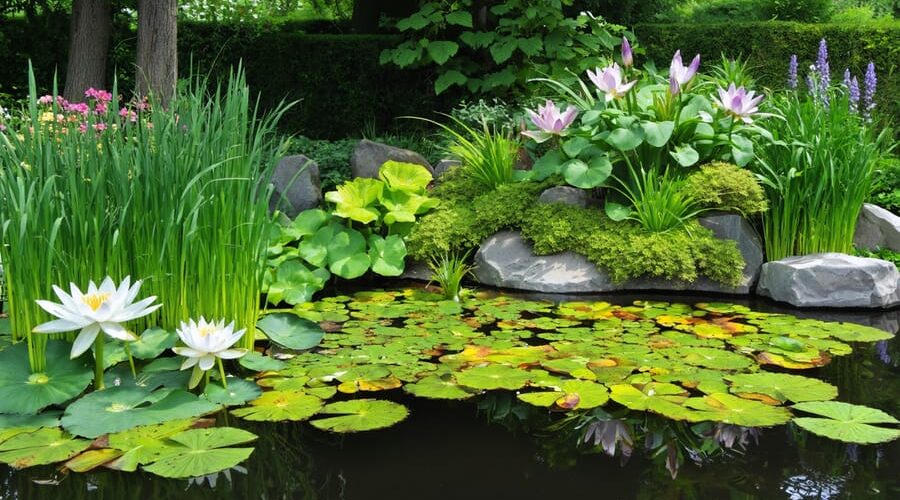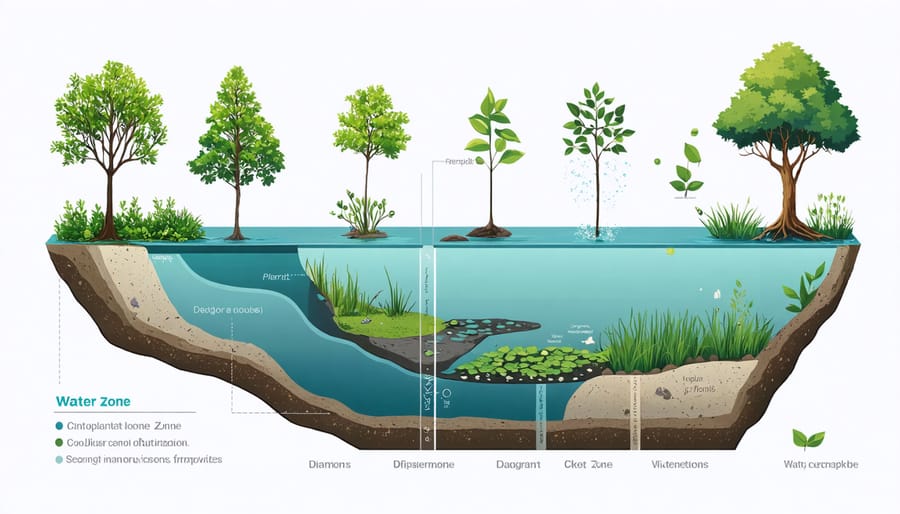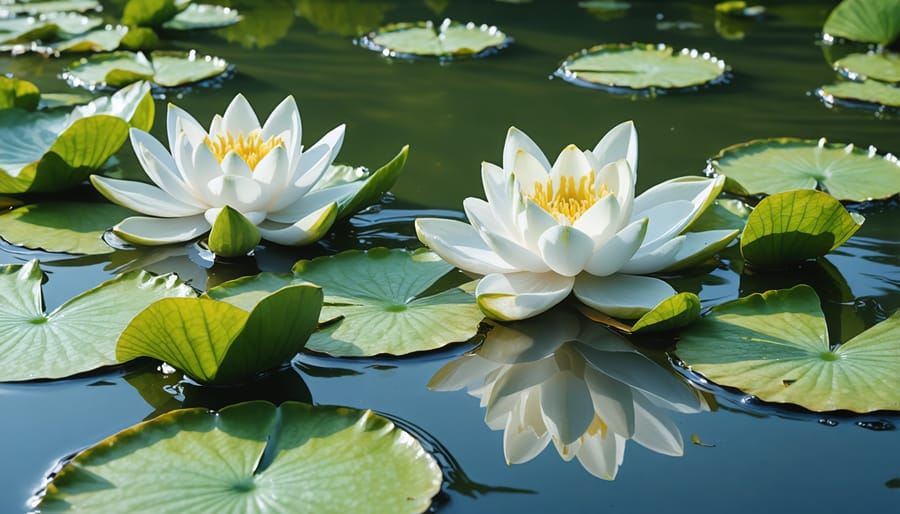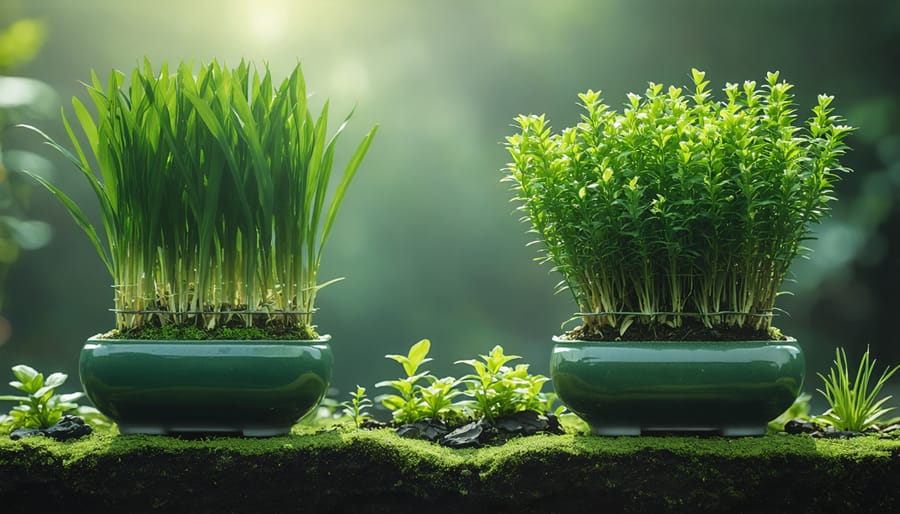
Tough-as-Nails Water Plants That Make Your Pond Thrive
Transform your outdoor water feature into a dream pond paradise with hardy aquatic plants that thrive in challenging conditions. From deep-rooted water lilies to resilient marginal plants, these aquatic powerhouses form the backbone of any successful water garden. Unlike their delicate counterparts, hardy water plants bounce back from temperature fluctuations, survive winter dormancy, and maintain their vigor year after year with minimal maintenance. These tough performers not only create stunning visual displays but also play crucial roles in maintaining pond health by filtering water, providing shelter for wildlife, and controlling algae growth naturally. Whether you’re a novice pond keeper or experienced water gardener, incorporating these resilient species ensures a thriving aquatic ecosystem that rewards you with reliable beauty and ecological benefits throughout the seasons.
What Makes a Water Plant ‘Hardy’?
Climate Resistance
Hardy water plants showcase remarkable adaptability to temperature fluctuations, making them perfect for year-round water gardens. Most varieties can withstand winter temperatures down to -20°F (-29°C) when their roots are protected below the water’s surface. During summer, these resilient plants thrive in temperatures up to 90°F (32°C) without showing signs of stress.
Many hardy water plants go dormant during winter, naturally protecting themselves by storing energy in their roots or rhizomes. Water lilies, for example, sink to deeper water during cold months and resurface when temperatures warm up. Rush and iris species maintain their adaptability by dying back to the crown, while their roots remain safely anchored in the pond substrate.
To maximize their climate resistance, plant them at appropriate depths according to their species requirements. Most hardy varieties bounce back vigorously in spring, often returning larger and more robust than the previous year. This seasonal cycle makes them reliable choices for water gardens in various climate zones.
Maintenance Requirements
Hardy water plants are remarkably self-sufficient, requiring minimal maintenance once established. Most varieties need only seasonal pruning to remove dead foliage and occasional division every 2-3 years to prevent overcrowding. During the growing season, a slow-release aquatic fertilizer applied once or twice is usually sufficient for optimal growth.
These resilient plants naturally resist common pond problems and help maintain water quality by absorbing excess nutrients. Winter care is straightforward – simply trim back dead growth and allow hardy varieties to go dormant naturally. Deep-water plants can remain in place year-round, while marginal plants might need moving to deeper water during freeze periods.
Disease resistance is a hallmark of hardy water plants, though occasional checking for signs of pest damage or algae growth is recommended. Most issues can be resolved by maintaining proper water depth and ensuring adequate spacing between plants. Regular monitoring of water levels and basic pond maintenance are typically all that’s needed to keep these sturdy plants thriving throughout the seasons.

Top Hardy Marginal Plants
Shallow Water Varieties
Shallow water areas in your pond offer the perfect home for a diverse range of hardy plants that add both beauty and functionality to your water garden. These plants thrive in depths ranging from 2 to 12 inches of water, making them ideal for pond margins and graduated shelves.
Marsh marigolds are among the most reliable choices, producing bright yellow blooms in spring and thriving in just a few inches of water. Sweet flag, with its striking vertical leaves, adds architectural interest and helps filter pond water naturally. For summer color, try the pickerelweed, which produces gorgeous purple flower spikes and grows happily in depths up to 12 inches.
Don’t overlook the classic water iris – these tough plants come in various colors and provide stunning vertical accents while helping to stabilize pond edges. Rushes and sedges are excellent choices for creating natural-looking transitions between water and land, and they’re incredibly easy to maintain.
For smaller spaces, water forget-me-nots create charming blue carpets of flowers just above the water’s surface. Another fantastic option is the hardy water canna, which brings tropical flair with its bold leaves and vibrant flowers while being surprisingly tough in temperate climates.
These shallow water plants not only beautify your pond but also provide valuable shelter for wildlife and help maintain water quality by absorbing excess nutrients.
Bank-Side Options
The transition area between your pond and garden offers exciting opportunities for creating a lush, natural-looking border. Plants that thrive in these moist conditions not only look beautiful but also help stabilize the bank and prevent erosion.
Iris varieties are perfect choices for bank-side planting, particularly Japanese and Yellow Flag Iris. These stunning plants produce vibrant blooms in spring and early summer while their strong roots help hold soil in place. Marsh Marigolds add cheerful splashes of yellow in early spring and naturalize easily in damp conditions.
For texture and height, consider ornamental grasses like Sweet Flag (Acorus) or Reed Canary Grass. These create wonderful movement in the breeze and provide year-round interest. Astilbe is another excellent choice, offering feathery plumes in shades of pink, red, and white, perfect for partially shaded areas.
Don’t overlook the charm of Lobelia cardinalis (Cardinal Flower) with its brilliant red spikes that attract hummingbirds, or the purple-blue blooms of Pickerelweed. For ground cover in moist areas, Creeping Jenny creates a carpet of golden-green foliage that trails beautifully over rocks and edges.
Remember to consider your hardiness zone when selecting bank-side plants, and ensure they won’t become invasive in your area. Most of these plants are low-maintenance once established, needing only occasional division every few years to keep them healthy and vibrant.
Hardy Floating Plants
Floating plants add a delightful dimension to any water garden, and the hardy varieties are particularly appealing for their resilience and low maintenance needs. These tough aquatic champions create natural shade for your pond while helping to maintain water quality and providing shelter for fish.
Among the most popular hardy floating plants is the water hyacinth, which showcases beautiful lavender blooms and creates thick mats of foliage that help reduce algae growth. While it’s vigorous (and should be controlled in some regions), it’s perfect for adding quick coverage to your pond surface.
Duckweed, another sturdy floating option, is incredibly adaptable and can survive in various water conditions. This tiny plant multiplies rapidly, making it an excellent choice for natural filtration, though you’ll want to manage its spread to prevent overcrowding. Like hardy water lilies, these floating plants return year after year with minimal care.
Water lettuce is another fantastic choice, featuring velvety, lime-green rosettes that float gracefully on the water’s surface. It’s particularly good at absorbing excess nutrients and providing spawning areas for fish. During winter, you might need to bring a few plants indoors to ensure next season’s growth in colder regions.
Azolla, also known as mosquito fern, is a hardy floating plant that forms dense mats and changes color with the seasons – from green in summer to red in fall. It’s excellent for natural mosquito control and works well in both small and large water features.
To maintain these hardy floating plants, simply remove excess growth periodically and ensure they don’t cover more than 60% of your pond’s surface. This balance allows for proper oxygen exchange while maintaining their beneficial effects on your water garden ecosystem.

Hardy Submerged Plants
Submerged plants are the unsung heroes of any healthy pond ecosystem, playing a vital role in helping to keep your water crystal clear while providing essential oxygen for fish and other aquatic life. These underwater warriors are particularly valuable because they work around the clock to maintain pond health.
One of the most popular hardy submerged plants is Hornwort (Ceratophyllum demersum), which thrives in various water depths and doesn’t require planting in soil. It simply floats freely, making it perfect for beginners. Anacharis (Elodea canadensis) is another excellent choice, known for its robust growth and ability to survive in cold waters.
For those looking to create underwater forests, Vallisneria, commonly known as tape grass or eel grass, offers long, ribbon-like leaves that wave gracefully in the water. This plant spreads through runners, creating a natural filtration system while providing shelter for small fish and aquatic creatures.
Water Milfoil (Myriophyllum) is another fantastic option, featuring delicate, feather-like leaves that effectively absorb excess nutrients from the water. It’s particularly good at competing with algae, helping to maintain clear water conditions throughout the season.
When incorporating these plants, start with one bunch per square foot of surface area. Most hardy submerged plants will thrive in depths between 2 and 5 feet, though some can adapt to deeper waters. During winter, these resilient plants typically go dormant but bounce back vigorously in spring.
Remember to thin out these plants periodically during the growing season, as their vigorous growth can sometimes overtake smaller ponds. This maintenance not only keeps your pond looking tidy but also helps remove excess nutrients from the water system, promoting better overall pond health.
Planting and Care Tips
Planting Techniques
Planting hardy water plants is straightforward when you follow the right techniques for each type. For marginal plants, start by placing them in aquatic planting baskets filled with heavy garden soil or aquatic compost. Position the crown (where stems meet roots) just above soil level, then top with gravel to prevent soil washing away.
For deep-water plants like water lilies, use wider baskets to accommodate their spreading roots. Plant them at an angle, with the growing tip pointing slightly upward. Cover with 2-3 inches of soil and add a gravel layer. Initially, place the basket in shallow water, gradually lowering it to its final depth over several weeks.
Floating plants require minimal effort – simply place them directly on the water’s surface. They’ll naturally spread and establish themselves. For submerged oxygenating plants, weight the stems with plant weights or tie them to small stones before dropping them into deeper water.
When planting bog garden species around pond edges, dig holes twice the width of the root ball in moist soil. Mix in organic matter for better moisture retention, place the plant at the same depth it was growing previously, and water thoroughly.
Remember to space plants appropriately – most hardy water plants will spread over time. For best results, plant in spring when water temperatures begin to rise, giving plants a full season to establish before winter.

Year-Round Maintenance
Maintaining hardy water plants throughout the year requires attention to seasonal changes and specific care routines. In spring, remove any dead foliage and divide overcrowded plants to promote healthy growth. Add slow-release aquatic fertilizer tablets to give your plants a nutrient boost as they enter their growing season.
Summer maintenance focuses on managing growth and maintaining water quality. Trim yellowing leaves promptly and remove spent blooms to encourage continuous flowering. Keep floating plants in check by removing excess growth, which helps maintain a self-sustaining ecosystem in your pond.
As autumn approaches, reduce fertilization and begin preparing plants for winter dormancy. Cut back marginal plants to about 2-3 inches above the water line. For winter care, move tropical varieties indoors if possible, and ensure hardy varieties are placed deep enough to prevent freezing – typically 12-18 inches below the surface.
Watch for common issues like yellowing leaves (often indicating nutrient deficiency), algae growth (suggesting imbalanced nutrients), or pest problems. If plants show signs of stress, check water parameters and adjust placement or depth as needed. Remember that even hardy varieties benefit from seasonal pruning and occasional division to maintain their vigor and appearance.
Regular monitoring of water quality and plant health will help you catch and address problems early, ensuring your aquatic garden thrives year-round.
Hardy water plants offer an exciting and rewarding way to enhance your pond or water garden with minimal fuss. As we’ve explored, these resilient plants not only create stunning visual displays but also contribute to maintaining a healthy aquatic ecosystem. From the majestic water lilies to the practical marginal plants, there’s a hardy water plant perfect for every water feature and gardening skill level.
Remember that success with hardy water plants comes down to choosing the right plants for your specific conditions, providing proper planting depth, and performing basic maintenance. While these plants are low-maintenance by nature, giving them a good start and occasional attention will ensure they thrive for years to come.
Whether you’re a beginner looking to dip your toes into water gardening or an experienced enthusiast wanting to expand your collection, hardy water plants are an excellent choice. Start small with a few reliable varieties, and as your confidence grows, experiment with different combinations to create your own unique aquatic paradise.
Take the plunge today and discover the joy of growing these remarkable plants. Your pond will thank you with years of beautiful blooms and lush greenery.
